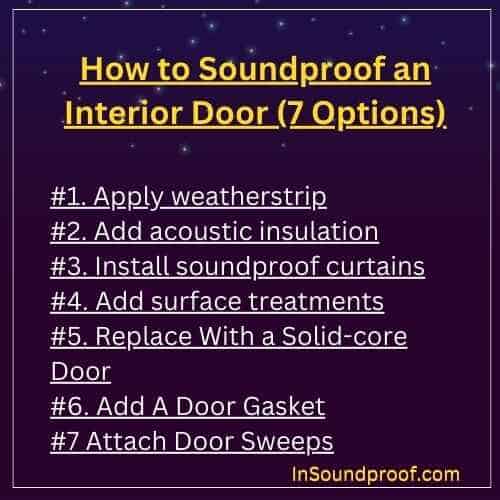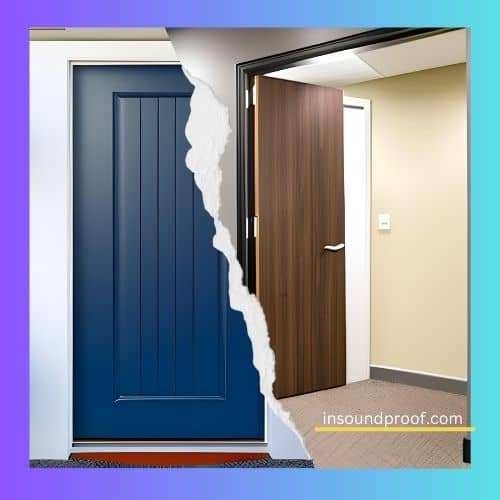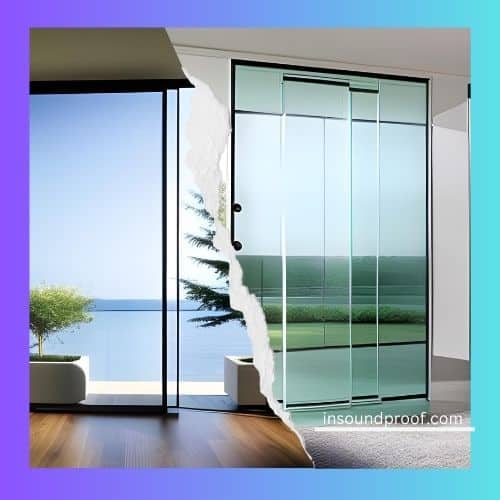If you have been kept up late at night because of a noisy neighbor or loud street traffic, you know just how important it is to have soundproofing in your home.
A soundproof interior door is a great way to keep the sound out of your home and to ensure that you and your family can enjoy the peace while you rest or relax.
Noise pollution has been linked to various negative health effects, including increased stress levels, hearing loss, sleep disturbances, cardiovascular problems, and cognitive impairment.
Prolonged exposure to loud noises can also cause headaches and fatigue. In addition, noise pollution can disrupt communication and social interaction.
Fortunately, even without expensive renovations, you can significantly reduce sound transmission through an interior door with simple and affordable soundproofing measures.
Read on to learn more about the steps to soundproof interior doors.
Soundproofing: Effective Ways to Soundproof French Doors

Table of Contents
How to Choose a Soundproof Interior Door
When shopping for a soundproof interior door, choose one of solid construction with good sound-deadening properties.
For an even greater level of soundproofing, consider a core foam-filled door — this will add further insulation and dampen more sound.
Various door seals are available that can help provide additional protection from outside noise.
Which Types of interior doors are more Soundproofed?
When choosing a soundproof interior door, it’s important to consider the type of door you’re looking for.
- Hinged doors are the most common and can be made from solid wood, aluminum, or steel. Solid wood doors are usually the most effective at blocking noise due to their density and mass. Aluminum and steel doors are both very durable and provide good sound insulation. Still, they will also be heavier than wood.
- Sliding, bi-fold, and pocket doors are not as effective at blocking sound, so these types are not recommended if you’re looking for a soundproof door.
- In addition to the type of door, you should also consider the thickness of the material. The thicker the material, the better it will be at blocking sound.
- Finally, look for doors with additional soundproofing features, such as rubber seals and weatherstripping, to reduce noise further.
Soundproofing: Methods to Soundproof Barn Door
Installing a Soundproof Interior Door
Once you’ve picked the right door for your needs, you want to install it carefully and properly.
- Start by leveling the doorway and framing it according to local building codes.
- Pay attention to the spacing around the edges of the frame — some materials need slightly more room than others, so double-check your measurements during installation.
- Once in place, device how best to seal any gaps or crevices between components.
- You can use weather stripping at the joints or caulk at window sills — as long as the air can’t enter, you’ll keep out outside noise.
- Finally, remember to use additional soundproof materials if needed.
Heavy curtains, double-pane windows, and acoustic panels can all help make your soundproof interior door even more effective.
Best Soundproof Interior Doors (8 Options)

Several types of soundproof interior doors are engineered to block outside noise and still provide privacy.
#1. Steel doors

These are strong and offer superior sound-blocking abilities.
They also provide fire resistance, so they’re a great choice for noise control in hospitals and schools.
Steel doors offer excellent soundproofing benefits and can be easily customized to suit specific needs.
They also provide superior fire resistance and are ideal for areas where noise needs to be blocked out, such as hospitals or schools.
#2. Solid Core Doors

Solid Core doors are constructed with a core of solid wood or composite material such as MDF plastic. These materials make the doors strong, durable, and relatively soundproof.
These doors are moderate to highly soundproof because of their Thick solid core materials. The thicker the door, the more sound
#3. Solid Wood Doors
These are heavier, costlier, and rated to last longer than solid core doors; however, they are more soundproof in some cases due to the gaps between panels.
Solid wood doors can be soundproofed though it may require some custom fabrication to achieve the desired soundproofing level, which includes adding insulation, additional layers of wood, or a door sweep to reduce air gaps around the edges of the door.
#4. Acoustic Doors
These doors feature a hollow core with insulating material for improved noise-blocking capabilities. Acoustic doors are typically made of metal, vinyl, or wood and come in various styles, allowing for greater personalization of your interior door design without sacrificing sound control qualities.
Acoustic doors are designed to provide the highest level of soundproofing available. Depending on the door’s size, material, and thickness, they can block up to 90% of sound. Additionally, acoustic seals and gaskets can be installed to reduce sound leakage around the door further.
#5. Laminated Glass Doors

Perfect for areas that require visibility but need to minimize still noise passing through.
Laminated glass offers more protection from outside sound than traditional windows, allowing you to view what’s happening outside the room or office space anytime.
Laminated glass doors offer good soundproofing, reducing noise by up to 30 dB. Therefore, they are suitable for applications in mid-level noise areas, such as office spaces and classrooms.
Additionally, the laminated glass can be combined with additional soundproof mechanisms, such as seals and gaskets around the door frame and acoustic panels within the frame, to improve performance.
When combined with acoustic seals and gaskets, laminated glass doors block up to 95% of sound.
However, remember that their effectiveness depends upon the thickness and type of glass used.
#6. Sliding Doors
These doors are great for open spaces or rooms where a conventional swinging door might not work, such as hallways and closets.
This type of door offers soundproofing benefits if constructed with insulated glass or covered in acoustic foam.
Sliding doors typically offer moderate levels of soundproofing.
The amount of soundproofing achieved largely depends on the construction materials used, such as the type and thickness of glass, wood panel, and insulation.
Laminated glass panels can provide up to 30dB of noise reduction.
Additionally, combining sliding doors with other acoustic solutions, such as seals and gaskets around the door frame and acoustic panels within the frame, can enhance soundproofing performance.
#7. Louvered Doors
These doors use parallel slats to provide ventilation and airflow while still giving some ability to control sound going in and out of the room.
Louvers can provide some noise control but are not typically considered an effective soundproofing solution. Be aware of this limitation before installing a louvered door.
Louvered doors can provide some sound insulation, but it is often limited.
In most cases, louvered doors are best used with other noise control measures like weatherstripping and acoustic seals to provide better soundproofing results.
#8. Fiberglass doors
These doors also provide sound insulation but with a much more lightweight feel. In addition, they can be customized with sound-absorbing materials and finishes to fit any situation.
Fiberglass doors can provide excellent sound insulation, depending on the construction and materials used.
Fiberglass doors can achieve good soundproofing results if reinforced with soundproofing panels and finishes.
Soundproofing: Nintendo Switch Fan Noise
How to Soundproof Interior Door (7 Options)
We have seen that different types of Doors have different levels of sound control. To further improve the soundproofing capabilities of a Door, there are some additional steps you can take:
#1. Apply weatherstrip
Weatherstripping on your door frame can help seal the gaps between the door and frame, preventing noise from entering or leaving the room.
Use a high-quality material when installing weatherstripping to improve the overall soundproofing performance.
The weatherstripping will help with soundproofing.
- To install it correctly, you need to measure the dimensions of the doorframe and purchase an appropriate-sized weatherstrip.
- Peel off the protective adhesive cover from the back of the weatherstrip and press it along the inside edge of the doorframe.
- Make sure to press firmly so that the seal is secure.
#2. Add acoustic insulation
Consider adding acoustic insulation like foam or fiberglass panels or blankets around your doorway for an even more effective soundproof door option.
Acoustic insulation helps absorb any sound that may pass through the gaps, making your interior room more secure from outside noise.
Acoustic insulation works by absorbing sound waves and trapping the energy between layers of material, preventing sound from traveling through the air and entering a room.
It also helps reduce noise reverberations inside the room, creating a quieter environment.
Acoustic insulation is particularly effective for blocking out relatively low-frequency noises, such as those caused by traffic or air conditioners.
#3. Install soundproof curtains
Soundproof curtains are a great way to add additional layers of protection to reduce noise pollution in your home or office space.
These heavy-duty insulating curtains can be used independently or with acoustic insulation panels or blankets to maximize soundproofing performance.
Soundproof curtains aid in soundproofing interior doors by providing an additional layer of insulation to absorb noise. When hung around a door, the thick material helps to block sound waves from entering the room.
Additionally, soundproof curtains act as a noise barrier between rooms, preventing loud conversations or other noises from spreading too far.
#4. Add surface treatments
Surface treatments such as mass-loaded vinyl (MLV) can also reduce noise if added to your door.
MLV is a heavy material loaded with lead particles providing an additional layer of soundproofing material in your doorway.
How do surface treatments for soundproof interior doors?
- Measure the dimensions of the door and purchase enough MLV to cover it.
- Cut the MLV to properly fit your door, allowing for a few inches of overlap on all sides.
- Install the MLV panels by starting at the top and working your way down. Secure each panel with adhesive or nails, depending on its thickness.
- Apply weather stripping to the exterior perimeter of your door frame to seal any gaps caused by fitting around all sides of the door frame, including any corners or crevices that may have been missed with your MLV installation.
#5. Replace With a Solid-core Door
Solid core doors are made from dense materials like wood, fiberglass, and metal, which help reduce sound penetration through the gaps. It is an ideal solution since the heavier weight of the material helps dampen sound transmission by absorbing and reducing vibrations that travel through it.
Solid core doors are typically constructed with sound-deadening material such as foam or fiberglass insulation sandwiched between two layers of wood or metal. It helps to absorb and dampen sound waves, preventing them from traveling through the door.
Additionally, weather stripping can be added around the door frame to reduce sound transmission further.
#6. Add A Door Gasket
Door gaskets are a great way to seal air leaks around your door and prevent sounds from vibrating through the gaps.
These foam seals come in various shapes and sizes and are essential for soundproofing any room.
These steps can help create a more soundproof door and reduce the amount of noise in or out of the room it’s installed in. In addition, you can easily DIY with the help of an interior door soundproofing kit.
#7 Attach Door Sweeps
Door sweeps are an effective way to soundproof an interior door. They are strips of rubber or vinyl that fit along the bottom of a door and provide an extra seal. Door sweeps are designed to block out noise, dust, and other unwanted elements from entering a room through gaps between the door and the floor.
When selecting a door sweep for soundproofing, look for one specifically designed for this purpose. For example, some door sweeps may need to be thicker or flimsy to block sound effectively. Additionally, make sure the sweep is the right size for your doorway.
To attach the door sweep to your interior door, use a drill to make pilot holes in your door frame and then screw in screws or nails through these holes into the frame. Be sure not to over-tighten screws, which can damage your door frame.
Why should we Soundproof an Interior Door?
Most rooms in a home are less soundproof than one would want, so it is important to have soundproof interior doors to help reduce the amount of outside noise that can enter the room.
Blocking the outside noise helps create a more peaceful environment and reduces distractions from outside noise.
Additionally, soundproofing an interior door can help to reduce the impact of sound traveling through walls, floors, and other items in the home.
Interior doors are an effective barrier for holding sound in one room or stopping it from spreading to other areas of your home.
A soundproofed interior door helps create better acoustics in any room, Preventing spreading sound and making conversations easier to follow without loud background noises interfering.
Conclusion
Using one of these seven options is an easy and cost-effective way to soundproof doors in your home without sacrificing comfort.
To maximize sound absorption in your room, we recommend combining techniques such as weatherstripping, acoustic insulation, curtains, mass-loaded vinyl, or replacing your existing door with a solid-core model.
10 FAQs about Soundproof Interior Door
Q 1: Can you soundproof an interior door?
Ans: Yes, you can soundproof an interior door using various materials. You can use mass-loaded vinyl, acoustic insulation, weatherstripping, curtains, or a solid core door to reduce noise pollution in your home or office space effectively.
Q 2: What type of interior door is most soundproof?
Ans: A solid core door is the most soundproof type of interior door. This type of door is made from solid wood and provides superior soundproofing capabilities compared to hollow core doors.
Q 3: Are solid doors more soundproof than hollow doors?
Ans: Yes, solid doors are more soundproof than hollow doors. Solid doors are made of solid wood, which is denser and more effective at blocking noise than hollow core doors.
Q 4: How to soundproof an interior door with glass?
Ans: To soundproof an interior door with glass, you can use acoustic insulation, weatherstripping, curtains, or a solid core door. Additionally, you can install double-pane windows to reduce noise pollution further.
Q 5: What is the best way to soundproof an interior door?
Ans: The best way to soundproof an interior door is to use a combination of materials. Mass-loaded vinyl is effective at blocking sound, as are acoustic insulation, weatherstripping, curtains, and solid core doors. Additionally, you can install double-pane windows to reduce noise pollution even further.
Q 6: How to soundproof the sliding interior door?
Ans: To soundproof a sliding interior door, you can use acoustic insulation, weatherstripping, curtains, or a solid core door. Additionally, you can install double-pane windows to reduce noise pollution even further. Finally, add mass to the door with mass-loaded vinyl or thicker door material, such as solid wood.
Q 7: How do you soundproof a hollow interior door?
Ans: To soundproof a hollow interior door, you can use acoustic insulation, weatherstripping, curtains, or a solid core door. Additionally, you can install double-pane windows to reduce noise pollution even further. Finally, add mass to the door with mass-loaded vinyl or thicker door material, such as solid wood.
Q 8: Does putting a towel under the door block sound?
Ans: Placing a towel under the door can help reduce sound, but it is not a foolproof solution. It will block some sounds, but the noise may still be audible. Consider installing acoustic insulation, weatherstripping, curtains, or a solid-core door for more effective soundproofing. Additionally, you can install double-pane windows to reduce noise pollution even further.
Q 9: How to DIY soundproof an interior door?
Ans: To DIY soundproof an interior door, you can use acoustic insulation, weatherstripping, curtains, or a solid core door. You can add more mass to the door with mass loaded vinyl or thicker door material, such as solid wood.
Q 10: How to soundproof a door with household items?
Ans: To soundproof a door with household items, you can use heavy curtains, blankets, or rugs to block sound from entering or leaving the room. You can also use foam weatherstripping to seal any gaps around the door. Additionally, you can place a towel or blanket at the bottom of the door to reduce noise coming through the crack.

